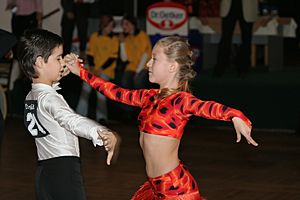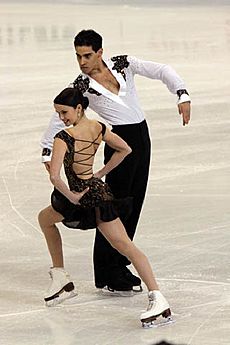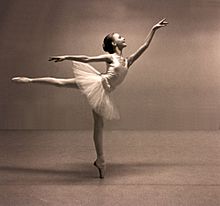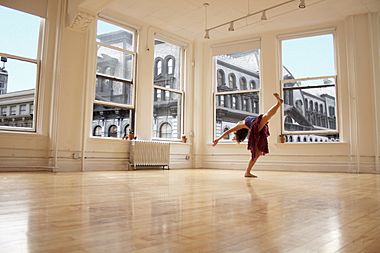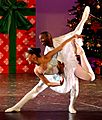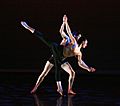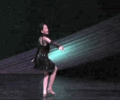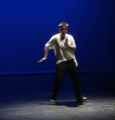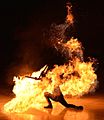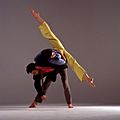Dance facts for kids
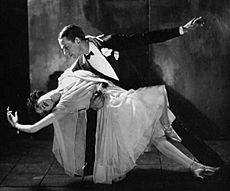
Dance is when people move to a musical rhythm. They may be alone, or in a group. The dance may be an informal play, a part of a ritual, or a part of a professional performance. There are many kinds of dances, and every human society has its own dances.
Dance is used as a form of exercise and occasionally training for other sports and activities. It has also become a sport for some. There are dancing competitions exhibiting various different styles and standards.
Dance is also an art. Some people dance to express their feelings and emotions. Other people dance to feel better. Dance can be used to tell a story. In some societies, dance goes with song as well as music. People who want to learn to dance can go to dance schools. It may take years of practice to become an experienced and flexible dancer.
To plan a dance is called choreography, done by a choreographer. Often this goes with music, and fits into a certain style. Dances may be planned in detail, or they may be whatever dancers feel like doing. However, most dancing does follow some general style or pattern. One style is the couple dance, where (usually) a man and a woman dance together. Other dances need a whole group of people together to make it work.
Contents
History
People have always danced. Every society has its own dances. There are pictures, on pottery and stone, which show dances from several thousand years ago, in Egypt and Greece.Chapter5
Sachs divides early dances into 'Imageless dances' and 'Image dances'. By 'imageless dances' he meant dances which have no set form, but aim at getting the dancers into a state of ecstasy. In this state the dancer(s) seem changed, in a trance, and are often thought of (by their society) as being 'possessed by spirits'. These dances are done on certain occasions: marriage, war, famine, illness or death, and so on. They are found in all early ('primitive') societies.p49; 62
The 'image dances', according to Sachs, are to do with the world outside the dancer. By imitating an animal or object, the dancer believes he can capture a power and make it useful. To dance in imitation of the animal which is going to be hunted is to become one with them. This is the kind of thinking behind an image dance. Sachs points out that societies of this kind do not really understand the connection between cause and effect. They really believe the image dances work. The dance type which is used in image dances is mime.p49; 77
The two styles of dance may be joined together. Fertility dances may involve both ecstatic states and mime. The great dancer Nijinsky used some of these ideas in his choreography for the ballet Le Sacre du Printemps (The Rite of Spring), a ballet about the sacrifice of a girl during a primitive celebration of Spring.
Coming to more recent times, the first dance school we know about was opened in 1661 in Paris. Only men were accepted until 1681. After 1681, women were accepted too. Ballroom dances are forms of modern dance. Ballroom dances such as the waltz are done by couples.
Until the 20th century, most ballroom dances were sequence dances. The way people moved was planned in set formation. These formations were usually lines or squares. Everyone moved at the same time, and finished at the same time. The music played for a set time, and then stopped. After the invention of the waltz, around 1800, another style of dancing developed. In the waltz, and later dances, people danced in couples, but they did so separately. They did not dance in formation, but moved round the room as they pleased (but anti-clockwise). Often, new dance styles arrive. Some dance as individuals, separately, as they please. Street dance is like that. All these types of dance have music.
At the same time, round the world there are many traditional dances. Some of them have been going for hundreds of years. We call them folkloric dances.
The coming of popular music videos and DVDs led to a kind of dancer previously seen in some stage shows. A backup dancer (or background dancer) is a performer who dances with or behind the lead performers in a live musical act or in a music video.
Styles
There are many different styles of dance, which fall into these general types:
- Professional dancing
- Social dancing
- Ballroom dancing (International style)
- Other styles
- Street dance
- Folk dance
- Irish Dance
- Morris Dance
- Country Dance
- Indian Classical Dances
- Bharat Natyam
- Kathak
- Mohini Attam
- Kathakali
- Kuchipudi
Education
Dance studies are offered through the arts and humanities programs of many higher education institutions. Some universities offer Bachelor of Arts and higher academic degrees in Dance. A dance study curriculum may include a diverse range of courses and topics, such as dance practice and performance, choreography, ethnochoreology, kinesiology, dance notation, and dance therapy. Most recently, dance and movement therapy has been integrated in some schools into math lessons for students with learning disabilities, emotional/behavioral disabilities and/or attention deficit hyperactivity disorder (ADHD).
Occupations
Dancers
Professional dancers are usually employed on contract or for particular performances or productions. The professional life of a dancer is generally one of constantly changing work situations, strong competitive pressure and low pay. Consequently, professional dancers often must supplement their incomes to achieve financial stability. In the U.S. many professional dancers belong to unions (such as the American Guild of Musical Artists, Screen Actors Guild and Actors' Equity Association) that establish working conditions and minimum salaries for their members. Professional dancers must possess large amounts of athleticism. To lead a successful career, it is advantageous to be versatile in many styles of dance, have a strong technical background and to use other forms of physical training to remain fit and healthy.
Teachers
Dance teachers typically focus on teaching dance performance, or coaching competitive dancers, or both. They typically have performance experience in the types of dance they teach or coach. For example, dancesport teachers and coaches are often tournament dancers or former dancesport performers. Dance teachers may be self-employed, or employed by dance schools or general education institutions with dance programs. Some work for university programs or other schools that are associated with professional classical dance (e.g., ballet) or modern dance companies. Others are employed by smaller, privately owned dance schools that offer dance training and performance coaching for various types of dance.
Choreographers
Choreographers are the ones that design the dancing movements within a dance, they are often university trained and are typically employed for particular projects or, more rarely may work on contract as the resident choreographer for a specific dance company.
Competitions

A dance competition is an organized event in which contestants perform dances before a judge or judges for awards, and in some cases, monetary prizes. There are several major types of dance competitions, distinguished primarily by the style or styles of dances performed. Dance competitions are an excellent setting to build connections with industry leading faculty members, adjudicators, choreographers and other dancers from competing studios. A typical dance competition for younger pre-professional dancers can last anywhere between two to four days, depending whether it is a regional or national competition.
The purpose of dance competitions is to provide a fun and educative place for dancers and give them the opportunity to perform their choreographed routines from their current dance season onstage. Often times, competitions will take place in a professional setting or may vary to non-performance spaces, such as a high school theatre. The results of the dancers are then dictated by a credible panel of judges and are evaluated on their performance than given a score. As far as competitive categories go, most competitions base their categories according to the dance style, age, experience level and the number of dancers competing in the routine. Major types of dance competitions include:
- Dancesport, which is focused exclusively on ballroom and latin dance.
- Competitive dance, in which a variety of theater dance styles, such as acrobatics, ballet, jazz, hip-hop, lyrical, stepping, and tap, are permitted.
- Commercial Dance, consisting of as hip hop, jazz , locking, popping, breakdancing, contemporary etc.
- Single-style competitions, such as; highland dance, dance team, and Irish dance, that only permit a single dance style.
- Open competitions, that permit a wide variety of dance styles. An example of this is the TV program So You Think You Can Dance.
- Olympic, Dance has been trying to be part of the Olympic sport since 1930s.
Professional dancers
- Alvin Ailey
- George Balanchine
- Vernon and Irene Castle
- Misty Copeland
- Katherine Dunham
- Bob Fosse
- Loie Fuller
- Gene Kelly
- Vaslav Nijinsky
- Margot Fonteyn
- Monsieur Pierre
- Antonio Ruiz Soler
Images for kids
-
Two modern dancers
-
Two women dance at a pop music concert in Sofia, Bulgaria.
-
The Waltz by Camille Claudel, 1905 cast
-
Tang dynasty female dancers
-
Ugandan youth dance at a cultural celebration of peace
-
An Indonesian Balinese dancer
-
Dance at Bougival by Pierre-Auguste Renoir (1883)
-
Two classical ballet dancers perform a sequence of The Nutcracker, one of the best known works of classical dance.
-
Dance partnering – a male dancer assists a female dancer in performing an arabesque, as part of a classical pas de deux.
-
Social dance – dancers at a juke joint dance the Jitterbug, an early 20th century dance that would go on to influence swing, jive, and jazz dance.
-
Latin Ballroom dancers perform the Tango.
-
Harlequin and Columbina from the mime theater in Copenhagen, Denmark
-
Prop dance – a fire dancer performance
-
Stage dance – a professional dancer at the Bolshoi Theatre
-
Ritual dance – Armenian folk dancers celebrate a neo-pagan new year.
-
Street dance – a Breakdancer performs a handstand trick.
-
Kebagh dance from Pagar Alam, Indonesia
See also
 In Spanish: Danza para niños
In Spanish: Danza para niños


